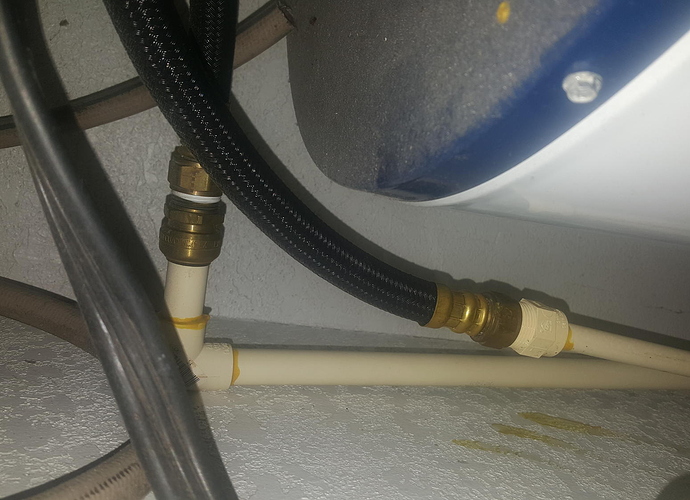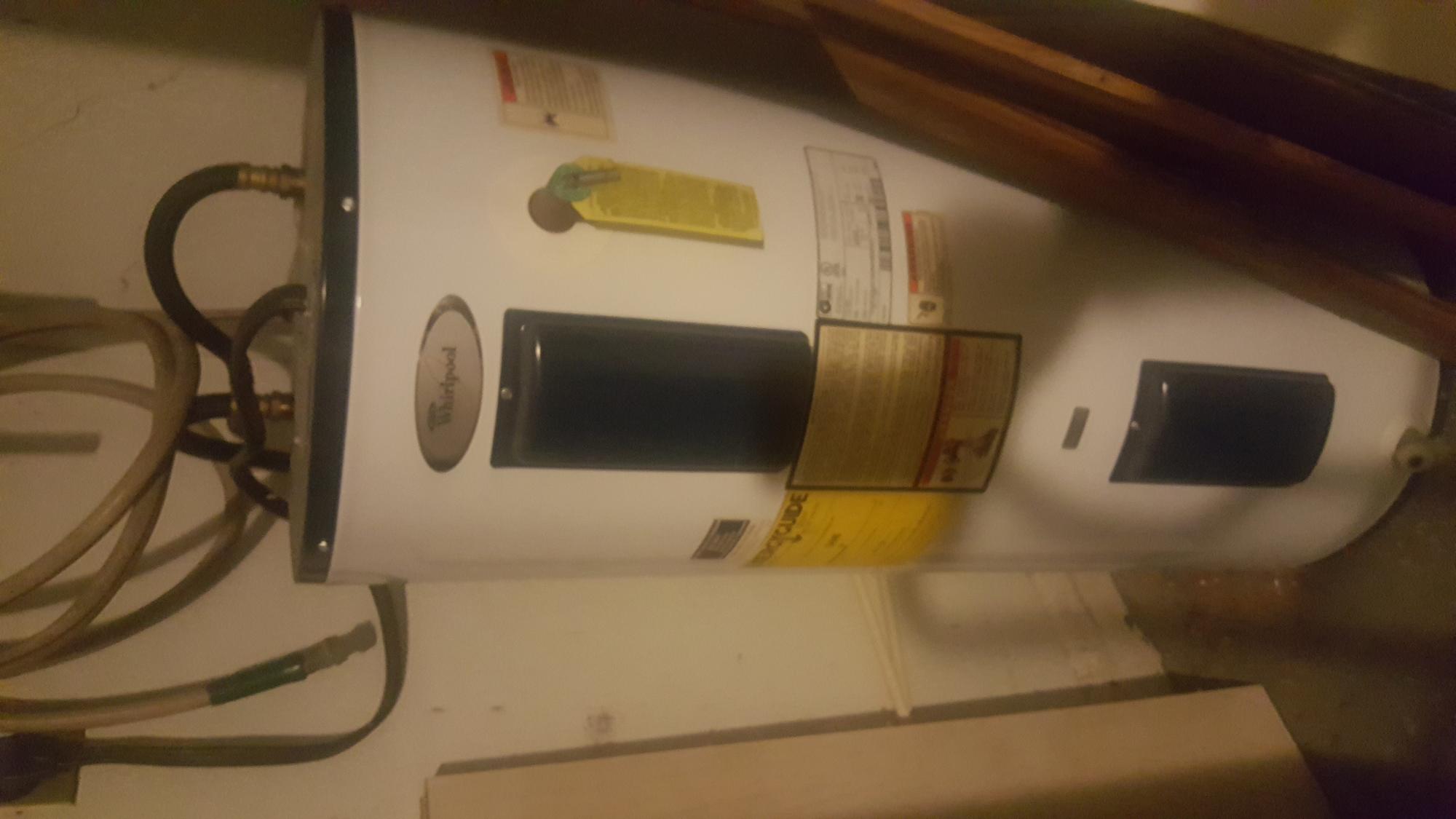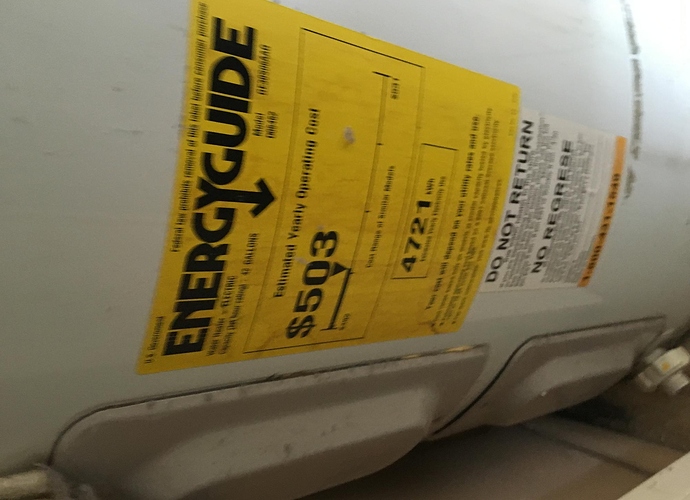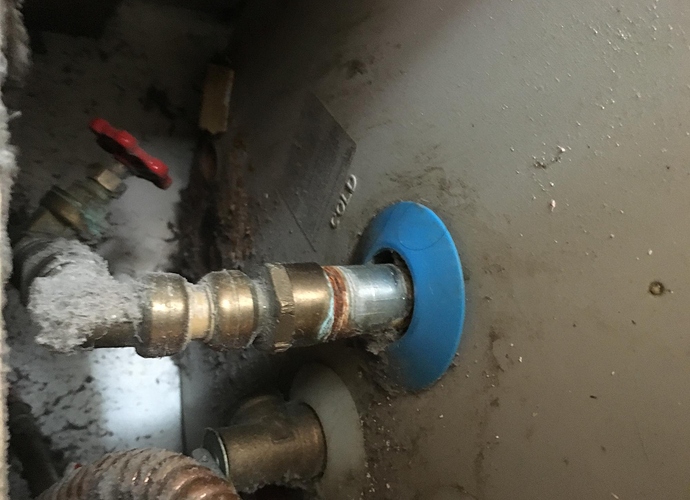I inspected the water heater at my own home as you can see from the pictures below there are all the manufacture stickers with warning and requirements and it has enough room for maintenance also the TPR valve is in the top 6 inches of the tank and there is a brass drain at the bottom of the tank the only thing I noticed about this that isn’t a defect but something worth mentioning is water inlet and outlet on top of the tank connect to the water line with compression fitting’s which are known to leak it was probably done this way though due to the plumbing pipes being cpvc instead of copper I would note this but not list it as a defect.
Water heater
Here we have a water heater of an apartment and it’s located in a closet at the end of the hallway. Right away you can see there are a few challenges with this water heater. On the side there is a date which indicates it’s installation and by that date being 2014 one would expect to see the presence of an expansion tank. Also pictured here is the water heater is in a pan which is good however, the pan is not plumbed to drain away any water in case of a leak.
Hot waster is defined as water above 110 degrees F. The water in my house is set to 115 Degrees F to prevent scalding and conserve a bit of energy.
We do not notice a difference in water temperature in our day to day lives, and take comfort in the fact that we will not be burned by our hot water.
Research essay:
Source:
Three Photos Every Inspector Should Include at the End of the Report
by Nick Gromicko and Kate Tarasenko
Being a good inspector includes being able to cover yourself in a time where you might be blamed for any damage. Water can potentially cause a lot of damage to a home ant necessarily right away. I really liked the idea of taking three separate photos of the water meter before you leave an inspection showing that there was no water running. As an added step in doing this it will let you know if there are any leaks that you might not have found because they are not visible that might need to be brought to the home owners attention.
I wanted to do a follow-up to my previous post on water heaters. I wanted to point out another challenge the heater had. If you take a close look you can see that there is no discharge pipe on the TPR valve. There are 13 requirements pointed out in our study material.
- It is incorrect for the pipe to directly connect to the drainage system.
- The pipe should consist of materials that are tested and rated for the approval of such use.
- Termination of the pipe should not be more than 6 inches above the floor. For the complete list of all 13 requirements you can refer to Residential Plumbing Overview section 5.16.
In this picture you can see a fairly new electric water heater installed. I am not a big fan of shark bite type connectors but they are allowed in the local building code as long as they are accessible and not covered up. I have never actually witnessed a leak using them but I have heard that if not properly installed the possibility exists.
Water heater expansion tanks.
It is my understanding that even though a expansion tank is not present its not a defect, however, an inspector must note it in his/her report.
I have attached a picture of my water heater; I’ve used this for electrical, as well. The label shows the water heater was made in 1994. The inspection shows no issues with rust and no signs of water leaking anywhere. The pan is broken and the TPR runs outside. The shut off valve is non functional and the electrical is unsafe.
I read “InterNACHI Water Heater Dating Chart” and “Water Heater Expansion Tanks” from the library. The dating chart is helpful if you can’t find an “Energy Guide” label which will show the year so you have an idea of about how old the water heater is. It’s helpful understanding how the expansion tank works in conjunction with the rest of the plumbing system. The expansion tank information has been covered in other sections but you can never know too much.
This State Select water heater was located in a crawlspace. IT was an 80 gal electric. The disconnect above the water heater was loose and double tapped. The TPR safety piping was also missing.
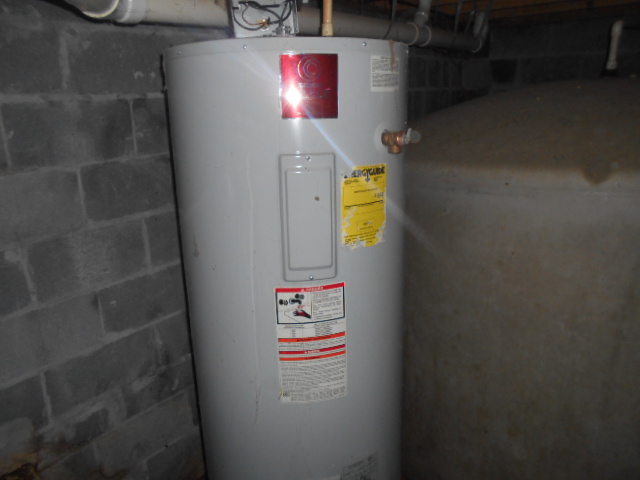
Here is a water heater for use by a guest house which is part of the main dwelling. There are two water heaters to this home, The main water heater is fairly new and to code, this water heater still works however its been in service for approx 15 years. Seismic retaining straps are not installed and should be located one at upper third and one at lower third.
I conducted my research exercise on “Zoning Ordinances for Inspectors” Most counties publish their zoning ordinances on the internet. Coincidentally, chapter 19.54 of my county ordinance addresses “Home Occupancy Permits” which is basically a business established at my home. There are a list of do’s and don’t(s). I think its important to become acquainted with zoning ordinances of the local jurisdiction in which the home inspector is conducting business. In some cases a permit is not required however, either way, the ordinance specifies “Operating Standards” which we must abide by, or else! :mrgreen:
Residential water heater of a town-home was located on the hallway in the kitchen area. It was an electric water heater with a 42 gallon capacity.
Unit located inside a closet with louvered doors provided room temperature with ventilation. Unit had 40 inches inches of frontal room area. In order to inspect the remaining 60% of the unit, the water heater would had to be removed. The obstruction was noted.
With limited visibility I was able to determine that the water heater did had a TPR Valve but no visible discharge pipe. TPR valve was located at the top of the unit and in case of discharge, depending on pressure it may scald or injury any person in the area. This is a safety hazard. Additionally, the lack of TPR discharge pipe, any discharge will leak onto the unit and cause further damages to it and surrounding materials.
Water Heater Expansion Tanks
by Nick Gromicko and Kenton Shepard
TPR valves are key to safety of home occupants. Water heater expansion tanks are enhanced measure to prevent air from becoming absorbed into the water, a process that could cause the expansion tank to lose its ability to act as a sort of shock absorber. As it is noted on the article, the presence of an expansion tank is not a substitute for TRP Valve. If for any reason temperature rises to 210 or pressure is exceeding 150 psi, the TPR valve would activate and discharge the excess. The expansion tank acts only as a cushion and any excess in the overall system would continue to fill the expansion tank, and the tpr valve would still fulfill its safety feature. The article mentions proper placing of the Expansion tank and its bracing. It is very common to find lose installations from 'homeowner specials"
RE: How to Inspect Water Heaters Tanks in Residential Units
Photo assignment
The attached photo shows an electric water heater inside a residential home.
The water heater had no apparent signs of leaks, the electrical connection was properly secured with a strain clamp and the TPR discharge pipe extended to within six inches (6") of the floor.
The only notable problem was that the water heater was installed inside the interior of the home without a water leak catch pan. At this residence, hardwood flooring made up fifty percent (50%) of the interior flooring.
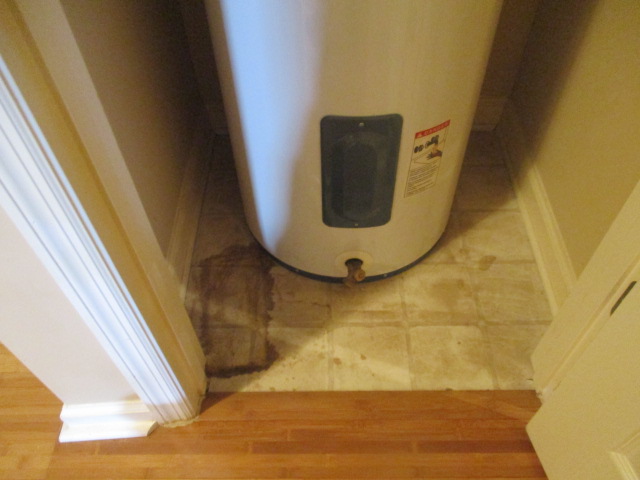
Terry L. Carson
Student Inspector


Attached photo is a brand new water heater in a crawl space of a house that has no water, hasn’t been lived in, in over 5 years
i read the article on deciphering serial#, model #'s on a water heater. It is incredibly helpful to know the year of manufacture and install.
Re: Inspecting Water Heaters
Article and Gallery assignments
Article:
Dryer Vent Safety
From the text…
InterNACHI believes that house fires caused by dryers are far more common than are generally believed, a fact that can be appreciated upon reviewing statistics from the National Fire Protection Agency. Fires caused by dryers in 2005 were responsible for approximately 13,775 house fires, 418 injuries, 15 deaths, and $196 million in property damage. Most of these incidents occur in residences and are the result of improper lint cleanup and maintenance. Fortunately, these fires are easy to prevent.
The article includes good information regarding the maximum lengths and how each bend and turn affects how you measure the dryer vent.
There are architects that do not get it. Laundry rooms are placed under stairs and in locations that make proper venting impossible.
A quick reminder - dryer vents should never exit in attics and crawlspaces.
Gallery:
Infrared Testing
This is a short Gallery but contains several interesting photos. Check out the electric panel comparisons between the naked eye and the infrared photo. It’s scary what the eye doesn’t see.
Terry L. Carson
Student Inspector
I just looked and inspected my water heater. We had it installed about 12 years ago. My close friend, who is a pipefitter took care of the installation, he purchased and installed the tank. I guess I should talk to him about the lack of a drip tube for the gas line. Oh well, you get what you pay for. 
Everything else appears to be ok and functional.
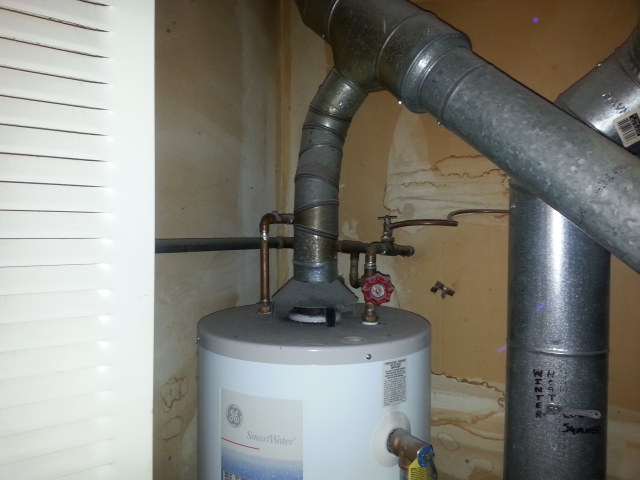
![20160830_234909[1].jpg](https://global.discourse-cdn.com/internachi/original/3X/0/d/0d22778dce46bea0b3650d8dd567db5f811178b9.jpeg)
![20160830_234855[1].jpg](https://global.discourse-cdn.com/internachi/original/3X/d/7/d76cd96003794ff3a921a486cea44c30e3adc3d7.jpeg)
Drip leg.
Seeing that my own water heater does not have a drip leg on the gas supply line, I researched the problem.
I have decided that I will need to install a drip leg on the gas supply system to the water tank.
